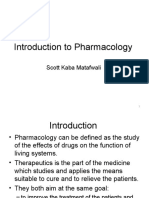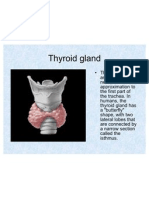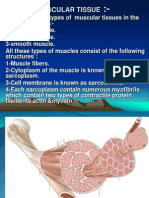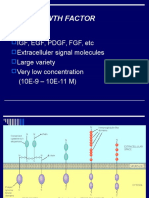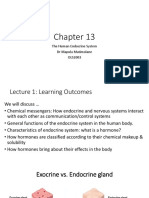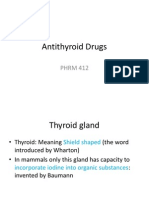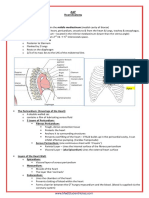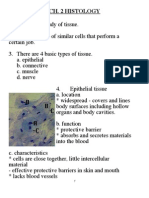0 ratings0% found this document useful (0 votes)
172 viewsHormones:: Signaling Molecules
Hormones:: Signaling Molecules
Uploaded by
Sangeeta DwivediHormones are signaling molecules produced by endocrine glands that are transported via bloodstream to target distant organs. They regulate physiology and behavior. There are several classifications of hormones based on proximity to target organ, solubility, proteinaceous nature, and mechanism of action. The pituitary gland located at the base of the brain regulates many other endocrine glands through releasing and inhibiting hormones.
Copyright:
© All Rights Reserved
Available Formats
Download as PPTX, PDF, TXT or read online from Scribd
Hormones:: Signaling Molecules
Hormones:: Signaling Molecules
Uploaded by
Sangeeta Dwivedi0 ratings0% found this document useful (0 votes)
172 views20 pagesHormones are signaling molecules produced by endocrine glands that are transported via bloodstream to target distant organs. They regulate physiology and behavior. There are several classifications of hormones based on proximity to target organ, solubility, proteinaceous nature, and mechanism of action. The pituitary gland located at the base of the brain regulates many other endocrine glands through releasing and inhibiting hormones.
Original Description:
hormones
Original Title
Hormones
Copyright
© © All Rights Reserved
Available Formats
PPTX, PDF, TXT or read online from Scribd
Share this document
Did you find this document useful?
Is this content inappropriate?
Hormones are signaling molecules produced by endocrine glands that are transported via bloodstream to target distant organs. They regulate physiology and behavior. There are several classifications of hormones based on proximity to target organ, solubility, proteinaceous nature, and mechanism of action. The pituitary gland located at the base of the brain regulates many other endocrine glands through releasing and inhibiting hormones.
Copyright:
© All Rights Reserved
Available Formats
Download as PPTX, PDF, TXT or read online from Scribd
Download as pptx, pdf, or txt
0 ratings0% found this document useful (0 votes)
172 views20 pagesHormones:: Signaling Molecules
Hormones:: Signaling Molecules
Uploaded by
Sangeeta DwivediHormones are signaling molecules produced by endocrine glands that are transported via bloodstream to target distant organs. They regulate physiology and behavior. There are several classifications of hormones based on proximity to target organ, solubility, proteinaceous nature, and mechanism of action. The pituitary gland located at the base of the brain regulates many other endocrine glands through releasing and inhibiting hormones.
Copyright:
© All Rights Reserved
Available Formats
Download as PPTX, PDF, TXT or read online from Scribd
Download as pptx, pdf, or txt
You are on page 1of 20
Hormones:
A hormone is a class of signaling molecules produced by glands in
multicellular organisms that are transported by the circulatory
system to target distant organs to regulate physiology and behavior.
Or
Hormones are substances produced by highly specialized tissues
called the "Endocrine" or "ductless glands", carried by blood stream
to a remote tissue or viscera called the "Target organ" on which they
exert characteristic physiological effects.
hormones classification on the basis on proximity of site
of synthesis to site of action
Autocrine Hormones: those that act on the same cells
that synthesize them;
Paracrine Hormones: those that are synthesized very
close to their site of action;
Endocrine Hormones: those that are synthesized by
endocrine glands and transported in the blood to target
cells that contain the appropriate receptors;
hormones classification on the basis of solubility in
aqueous medium in cells
• Hydrophilic Hormones (Lipophobic Hormones); Hormones
that are soluble in aqueous medium; They cannot cross the
cell membrane, Thus, they bind to receptor molecules on the
outer surface of target cells, initiating reactions within the cell
that ultimately modifies the functions of the cells;
Examples: Insulin, Glucagon, Epinephrine
• Lipophilic Hormones (Hydrophobic Hormones); Hormones
that are not soluble in aqueous medium, but soluble in lipid;
They can easily cross the cell membrane, Thus, they can
enter target cells and bind to intracellular receptors to
carryout their action;
Examples: Thyroid hormones, Steroid hormones;
• Classification of Hormones: On the
bases of proteinaceous nature Hormones are
classified into two groups:
I. Proteinaceous Hormones (Peptide
Hormones)
II. Non proteinacous Hormones (Steroid
Hormones)
Proteinaceous Hormones (Peptide Hormones)
Peptide hormones are proteins that have an effect on the endocrine
system of animals.
Like other proteins, peptide hormones are synthesized in cells from
amino acids according to mRNA transcripts.
Several important peptide hormones are secreted from the pituitary
gland.
The anterior pituitary secretes three: prolactin, which acts on the
mammary gland; adrenocorticotropic hormone (ACTH), which acts on
the adrenal cortex to regulate the secretion of glucocorticoids and
growth hormone, which acts on bone, muscle, and the liver.
The posterior pituitary gland secretes antidiuretic hormone, also called
vasopressin, and oxytocin.
Peptide hormones are produced by many different organs and tissues
like pancreas (glucagon, insulin and somatostatin), the gastrointestinal
tract (cholecystokinin, gastrin).
Main Peptide Hormones: Insulin , Glucagon , Adrenocorticotropic hormone (ACTH) , Antidiuretic hormone
(ADH) , Oxytocin , Prolactin
Classification according to mechanism of a Hormones
Hormone which bind to intracellular receptors
Hormones, which bind to membrane receptors
Mechanism of Hormonal Action
Hormones, which bind to membrane receptors
• The hormones that are protein or amines in compositions such
as Growth hormone, ADH, oxytocin, Insulin, Adrenaline, FSH,
TSH etc shows this mechanism of action.
• These hormones are water soluble and cannot passes through
the lipid membrane and they have their target receptor on the
cell membrane. The receptor are fixed on the cell membrane, so
hormone can bind on the specific receptor.
• Binding of hormone on specific receptor on target cell activates
the enzyme Adenylcyclase in the cell membrane and causes
production of cyclic AMP (cAMP).
•cAMP act as secondary messenger. It diffuse through the cell membrane and activates
(Protein Kinase) various enzymatic reaction to cause biochemical changes. After the target cell
responded to the changes, cAMP is deactivated by a group of enzymePhosphodiesterase
Mobile receptor mechanism
• The lipid soluble hormones such as steroid hormones and
Fatty acids hormones can easily passes through the
plasma membrane.
• They have their receptor inside the cell, freely floating in
the cytoplasm. Binding of hormone to the specific
receptor activates the enzymatic activity of the cell for
biochemical changes.
• Some hormones (testosterone, progesterone, estrogen,
cortisol, thyroxine) have their receptor localized inside the
nucleus, the hormone-receptor complex are carried inside
the nucleus.
• The hormone-receptor complex initiate transcription of
the DNA to form specific mRNA.
• mRNA initiate protein synthesis in the cytoplasm. The
protein (enzyme) causes biochemical changes in the cell.
The pituitary gland
• The pituitary gland or Hypophysis Cerebri is an ovoid structure of about
0.5 gm in adults. It is connected to the brain through a stalk called
Infundibulum.
The pituitary is divided into two lobes.
• The anterior Pituitary.
• The Posterior Pituitary
The Anterior Pituitary
Hypothalamus (a region of brain) controls the anterior pituitary by
producing:
• The Releasing Hormone: Stimulates the release of pituitary
hormones.
• The Inhibiting Hormone: Inhibits the release of pituitary
hormones.
RH and IH are produced in the cell bodies of neurosecretory neurons. • They
are stored in the ends of the axons(present just above the pituitary) until
needed. • When released, the hormones diffuse into capillaries draining
into veins which in turn drain into capillaries of pituitary. • They then bind
to the target cells causing them to release hormones
Origin and location of Pituitary Gland
• The pituitary gland is also called The Hypophysis, is
the smallest endocrine gland.
• Hypophysis (meaning undergrowth) is so named
because of its location below the brain as
undergrowth.
• This is an unpaired small ovoid gland and is no longer
than the end of the little finger.
• It is located at the base of the brain and lies below the
diencephalon in a depression of basis phenoid bone
of the skull called Sella Turcica.
• It is a complex structure formed of ectodermic growth
of the mouth cavity and down growth of the
infandibulum.
• Anterior Pituitary
• The anterior pituitary or adenohypophysis secretes hormones that
regulate a wide range of bodily activities, from growth to reproduction.
Release of anterior pituitary hormones is stimulated by releasing
hormones and suppressed by inhibiting hormones from the
hypothalamus.
• Thus, the hypothalamic hormones are an important link between the
nervous and endocrine systems.
Hypophyseal Portal System
• Hypothalamic hormones reach the anterior pituitary through a portal
system.
• In a portal system, blood flows from one capillary network into a portal
vein, and then into a second capillary network without passing through
the heart.
• In the hypophyseal portal system , blood flows from capillaries in the
hypothalamus into portal veins that carry blood to capillaries of the
anterior pituitary.
Types of Anterior Pituitary Cells
1. Somatotrophs secrete human growth hormone (hGH) or somatotropin”:
Human growth hormone in turn stimulates several tissues to secrete
insulinlike growth factors, hormones that stimulate general body growth and
regulate aspects of metabolism.
2. Thyrotrophs secrete thyroid-stimulating hormone (TSH)
or thyrotropin :TSH controls the secretions and other activities of the thyroid
gland.
3. Gonadotrophs secrete two gonadotropins: follicle-stimulating hormone
(FSH) and luteinizing hormone. FSH and LH both act on the gonads. They
stimulate secretion of estrogens and progesterone and the maturation of
oocytes in the ovaries, and they stimulate sperm production and secretion of
testosterone in the testes.
4. Lactotrophs secrete prolactin (PRL), which initiates milk production in the
mammary glands.
5. Corticotrophs secrete adrenocorticotropic hormone
(ACTH) or corticotropin , which stimulates the adrenal cortex to
secreteglucocorticoids such as cortisol. Some corticotrophs, remnants of the
pars intermedia, also secrete melanocyte-stimulating hormone
(MSH).
Human Growth Hormone and Insulinlike
Growth Factors
• Somatotrophs are the most numerous cells in the anterior pituitary, and
human growth hormone (hGH) is the most plentiful anterior pituitary
hormone. The main function of hGH is to promote synthesis and
secretion of small protein hormones called insulinlike growth factors
(IGFs) or somatomedins.
In response to human growth hormone, cells in the liver, skeletal
muscles, cartilage, bones, and other tissues secrete IGFs, which
may either enter the bloodstream from the liver or act locally .
The functions of IGFs include the following:
• 1. IGFs cause cells to grow and multiply by increasing uptake
of amino acids into cells and accelerating protein synthesis.
IGFs also decrease the breakdown of proteins and the use of amino
acids for ATP production. Due to these effects of the IGFs, human
growth hormone increases the growth rate of the skeleton and skeletal
muscles during childhood and the teenage
In adults, human growth hormone and IGFs help maintain the
mass of muscles and bones and promote healing of injuries
and tissue repair.
2. IGFs also enhance lipolysis in adipose tissue, which results in
increased use of the released fatty acids for ATP production by
body cells.
3. In addition to affecting protein and lipid metabolism, human
growth hormone and IGFs influence carbohydrate metabolism
by decreasing glucose uptake, which decreases the use of
glucose for ATP production by most body cells. This action
spares glucose so that it is available to neurons for ATP
production in times of glucose scarcity. IGFs and human
growth hormone may also stimulate liver cells to release
glucose into the blood
• Their secretory activity is controlled mainly by
two hypothalamic hormones:
(1) growth hormone–releasing hormone (GHRH)
promotes secretion of human growth hormone,
and
(2) Growth hormone–inhibiting hormone (GHIH)
suppresses it.
Follicle-stimulating Hormone
• In females, the ovaries are the targets for follicle-
stimulating hormone (FSH). Each month FSH initiates the
development of several ovarian follicles, saclike
arrangements of secretory cells that surround a
developing oocyte. FSH also stimulates follicular cells to
secrete estrogens (female sex hormones). In males, FSH
stimulates sperm production in the testes.
Gonadotropinreleasing hormone (GnRH) from the
hypothalamus stimulates FSH release. Release of GnRH
and FSH is suppressed by estrogens in females and by
testosterone (the principal male sex hormone) in males
through negative feedback systems. There is no
gonadotropin-inhibiting hormone.
You might also like
- Byol Maridian ChartDocument2 pagesByol Maridian ChartPranicHealingCentre67% (9)
- Introduction - To - Pharmacology PowerPointDocument16 pagesIntroduction - To - Pharmacology PowerPointAngetile KasangaNo ratings yet
- Fact File Gastro Intestinal HormonesDocument2 pagesFact File Gastro Intestinal HormonesSudip DevadasNo ratings yet
- Soojeedes Human Anatomy and Physiology PDFDocument119 pagesSoojeedes Human Anatomy and Physiology PDFmaxamed Buule IsaaqNo ratings yet
- Biochemistry of Hormones 1Document21 pagesBiochemistry of Hormones 1Hazel Grace BellenNo ratings yet
- Endocrine System &gland ChartDocument18 pagesEndocrine System &gland ChartMerlintaNo ratings yet
- Anatomy of The Digestive System and Circulatory SystemDocument17 pagesAnatomy of The Digestive System and Circulatory SystemRafael Quieta Claro Jr.No ratings yet
- Male Fertility Disorder 2014Document56 pagesMale Fertility Disorder 2014Fia Delfia AdventyNo ratings yet
- Problem Based Learning Case Study Thyroid DisorderDocument30 pagesProblem Based Learning Case Study Thyroid DisorderdrnawafNo ratings yet
- With Important Actions On Smooth MuscleDocument90 pagesWith Important Actions On Smooth MuscleGeraldine Marie Salvo100% (1)
- Histamine and Histamine Antagonists-08Document26 pagesHistamine and Histamine Antagonists-08James PerianayagamNo ratings yet
- Lecture 2 - HomeostasisDocument27 pagesLecture 2 - HomeostasisAndre Luis CostaNo ratings yet
- Thyroid GlandDocument30 pagesThyroid GlandahmedkomranNo ratings yet
- Pharmacotherapy For GERDDocument6 pagesPharmacotherapy For GERDJoon HyungNo ratings yet
- PITUITARYDocument37 pagesPITUITARYaparna shamaNo ratings yet
- Blood and Body FluidsDocument24 pagesBlood and Body FluidsQasim NaeemNo ratings yet
- Medical Statistics... Prof Bamgboye E.A. - OptimisedDocument43 pagesMedical Statistics... Prof Bamgboye E.A. - Optimisedfolorunsho abdullahiNo ratings yet
- Drugs Effecting On Thyroid Gland: Abdullaev Dzhumadil, PharmdDocument22 pagesDrugs Effecting On Thyroid Gland: Abdullaev Dzhumadil, PharmdRtxGaming Zone 73No ratings yet
- Muscular TissueDocument18 pagesMuscular Tissueabbaslafe100% (1)
- Hormon GDSDocument23 pagesHormon GDSBRI KUNo ratings yet
- Hormones TableDocument84 pagesHormones TableSaajid AmraNo ratings yet
- Chapter 11 - Endocrine SystemDocument7 pagesChapter 11 - Endocrine SystemAla RasiNo ratings yet
- Endocrine Group 1Document25 pagesEndocrine Group 1Shermine Keith DoctoleroNo ratings yet
- Axial Skeleton PDFDocument48 pagesAxial Skeleton PDFSharadambigai SamarasanNo ratings yet
- Gastrointestinal Infections Shigellosis InfectionsDocument6 pagesGastrointestinal Infections Shigellosis InfectionsNishita ChandNo ratings yet
- Actions of Thyroid Hormone: Dr. Ayisha Qureshi Assistant Professor MBBS, MphilDocument41 pagesActions of Thyroid Hormone: Dr. Ayisha Qureshi Assistant Professor MBBS, MphilJyoti ChadhaNo ratings yet
- Chapter 29 - Endocrine FunctionDocument6 pagesChapter 29 - Endocrine Functionhgfree41392No ratings yet
- Biochemistry of Hormones (Part 1)Document31 pagesBiochemistry of Hormones (Part 1)arun231187100% (2)
- Anti-Thyroid DrugsDocument60 pagesAnti-Thyroid DrugsApurba Sarker Apu100% (2)
- Factors That Affect Enzyme Activity 101Document1 pageFactors That Affect Enzyme Activity 101Funtilar Mary FransNo ratings yet
- The Blood: Rubie Maranan-Causaren, MSDocument73 pagesThe Blood: Rubie Maranan-Causaren, MSlady ann jimenez100% (3)
- Endocrine System Report (ANATOMY)Document24 pagesEndocrine System Report (ANATOMY)Pen TuraNo ratings yet
- Signal TransductionDocument38 pagesSignal Transductionjuju100% (2)
- Lectures 1 3 Handout For PrintingDocument43 pagesLectures 1 3 Handout For Printingkriss Wong100% (2)
- What Is HomeostasisDocument2 pagesWhat Is HomeostasisChidinma Glory EjikeNo ratings yet
- Gland Hormone Function Target Organ (Name or Picture) : HypothalamusDocument2 pagesGland Hormone Function Target Organ (Name or Picture) : HypothalamusRoya ImaniNo ratings yet
- Signal TransductionDocument17 pagesSignal TransductionElaine PuiNo ratings yet
- The Human Body: An OrientationDocument44 pagesThe Human Body: An OrientationMica Bernardo100% (1)
- Body System ChecklistDocument6 pagesBody System Checklistapi-422967453No ratings yet
- Photobiology PPT by DR AkbarDocument27 pagesPhotobiology PPT by DR AkbarAyesha awanNo ratings yet
- The Healing Power of Chinese Herbs and Medicinal Recipes (PDFDrive)Document1,122 pagesThe Healing Power of Chinese Herbs and Medicinal Recipes (PDFDrive)KuntoNo ratings yet
- Pituitary GlandDocument15 pagesPituitary GlandPutri Agustin Mere100% (1)
- Fluid, Electrolyte, and Acid Balance SherwoodDocument32 pagesFluid, Electrolyte, and Acid Balance SherwoodEvan PermanaNo ratings yet
- Lymphatic Drainage of HNFDocument80 pagesLymphatic Drainage of HNFMehek Batra100% (1)
- 02 HemoglobinDocument78 pages02 HemoglobinpixiedustNo ratings yet
- Endocrine PhysiologyDocument79 pagesEndocrine PhysiologyCHALIE MEQUNo ratings yet
- Last Minute RevisionDocument229 pagesLast Minute RevisionSelvaArockiamNo ratings yet
- (HISTOLOGY) Endocrine SystemDocument11 pages(HISTOLOGY) Endocrine Systemwipi112No ratings yet
- Heat Shock ProteinsDocument98 pagesHeat Shock ProteinsAprianie Wiwin100% (1)
- Animal Diseases CollectionDocument94 pagesAnimal Diseases CollectionNabin Kumar YadavNo ratings yet
- Lecture 22 - Histamine & Anti-HistamineDocument17 pagesLecture 22 - Histamine & Anti-Histamineapi-3703352100% (3)
- Research Paper - High CholesterolDocument5 pagesResearch Paper - High Cholesterolapi-291670255No ratings yet
- Biochem. - HORMONES - DR - MENDOZADocument14 pagesBiochem. - HORMONES - DR - MENDOZAJulianne PatalinghugNo ratings yet
- Metab DisordersDocument36 pagesMetab DisordersDaena TimtimanNo ratings yet
- DSL - Thyroid Function TestDocument7 pagesDSL - Thyroid Function TestUmar AzlanNo ratings yet
- Biology Notes Human Digestive System For SSC Exam PDFDocument2 pagesBiology Notes Human Digestive System For SSC Exam PDFनितीन लाठकरNo ratings yet
- Hyperprolactine MIA: Prepared By: Daryl S. AbrahamDocument15 pagesHyperprolactine MIA: Prepared By: Daryl S. AbrahamBiway RegalaNo ratings yet
- Endocrine Pathophysiology: Doc. Mudr. Ing. Rndr. Peter Celec, DRSC., MPHDocument121 pagesEndocrine Pathophysiology: Doc. Mudr. Ing. Rndr. Peter Celec, DRSC., MPHS ARUNA100% (1)
- Lecture 2 Prescription and Latin TermsDocument18 pagesLecture 2 Prescription and Latin TermsAlfred ChowNo ratings yet
- CAR-T Cell TherapyDocument11 pagesCAR-T Cell Therapyhpickett100% (1)
- EndocrinologyDocument74 pagesEndocrinologysyedahaleemajunaidsNo ratings yet
- Liver Chemistry and Function Tests: Daniel S. PrattDocument11 pagesLiver Chemistry and Function Tests: Daniel S. PrattAnişoara FrunzeNo ratings yet
- Anatomy and Physiology,: Lecture OutlineDocument37 pagesAnatomy and Physiology,: Lecture OutlinelouradelNo ratings yet
- Physiological PsychologyDocument65 pagesPhysiological PsychologyIkponmwosa Eseosa100% (1)
- Anatomy ProstateDocument2 pagesAnatomy ProstatenavjavNo ratings yet
- Chakra Genesis, A Correlation Between Evolution of Chakras EmbryogenesisDocument8 pagesChakra Genesis, A Correlation Between Evolution of Chakras EmbryogenesisChandan TiwariNo ratings yet
- Questions About KidneysDocument30 pagesQuestions About KidneysKristine Mae AbrasaldoNo ratings yet
- Cranial Nerve Mnemonics 101110.2Document13 pagesCranial Nerve Mnemonics 101110.2porphyrin rheniumNo ratings yet
- 5 D4 Pemberian Diet Pada CKDDocument29 pages5 D4 Pemberian Diet Pada CKDPinny Rilenda L NgaraNo ratings yet
- Jurnal HipotiroidDocument10 pagesJurnal HipotiroidreyhanrrNo ratings yet
- A&P - 1. Heart Anatomy (9p)Document9 pagesA&P - 1. Heart Anatomy (9p)mr. fakeNo ratings yet
- Fizyoloji Ingilizce KitapDocument389 pagesFizyoloji Ingilizce KitapnedimsacikaraNo ratings yet
- There Are No Three Physiological Narrowings in The Upper Urinary Tract: A New Concept of The Retroperitoneal Anatomy Around The UreterDocument7 pagesThere Are No Three Physiological Narrowings in The Upper Urinary Tract: A New Concept of The Retroperitoneal Anatomy Around The UreterqweqweqwNo ratings yet
- Biology and Chemistry TopicsDocument9 pagesBiology and Chemistry TopicsJanine CerradaNo ratings yet
- MCQSDocument13 pagesMCQSUzair Khan100% (1)
- A Change of Heart: The Tryst Between Indian Surgeons and Heart TransplantsDocument4 pagesA Change of Heart: The Tryst Between Indian Surgeons and Heart TransplantsJuhi NeogiNo ratings yet
- Adaptive and Innate ImmunityDocument63 pagesAdaptive and Innate ImmunitySarvesh Patil100% (1)
- Circulation: Campbell Biology: Concepts & ConnectionsDocument88 pagesCirculation: Campbell Biology: Concepts & ConnectionsBehshxbxNo ratings yet
- Sensory WordsDocument4 pagesSensory Wordsfelipe.flores.paineviloNo ratings yet
- Heart SoundsDocument23 pagesHeart SoundsK.R.RaguramNo ratings yet
- Pathology of The Bile Duct 2017 - Yasuni Nakanuma PDFDocument215 pagesPathology of The Bile Duct 2017 - Yasuni Nakanuma PDFHîrjoabă IoanNo ratings yet
- Skin WorksheetDocument2 pagesSkin WorksheetUZ - 11VT 686029 Lincoln Alexander SSNo ratings yet
- Cardiac CycleDocument18 pagesCardiac CycleSethu SankaranNo ratings yet
- Ch.2 Histology NotesDocument12 pagesCh.2 Histology NotesStephanie M. Lazo100% (1)
- Learn About Pancreatic CancerDocument5 pagesLearn About Pancreatic CancersalemmanipalNo ratings yet
- 13 - Respiratory SystemDocument68 pages13 - Respiratory SystemNur Shahirah Nasir Faculty of Social Science and FoundationNo ratings yet
- Rat DissectionDocument7 pagesRat Dissectionapi-236289588No ratings yet
- Understanding The Respiratory and Circulatory SystemsDocument33 pagesUnderstanding The Respiratory and Circulatory Systemschubbychaps786No ratings yet
- Kidney FunctionDocument4 pagesKidney FunctionEinah EinahNo ratings yet

